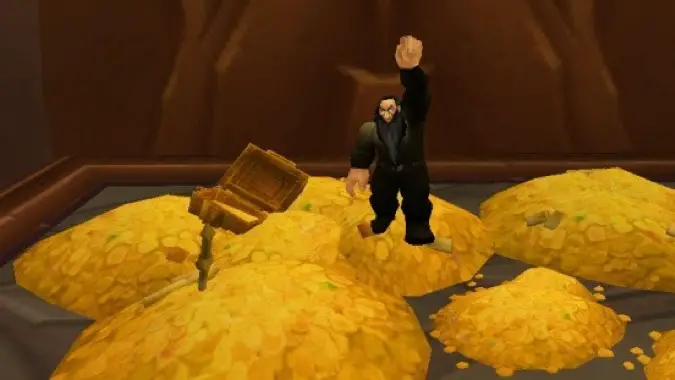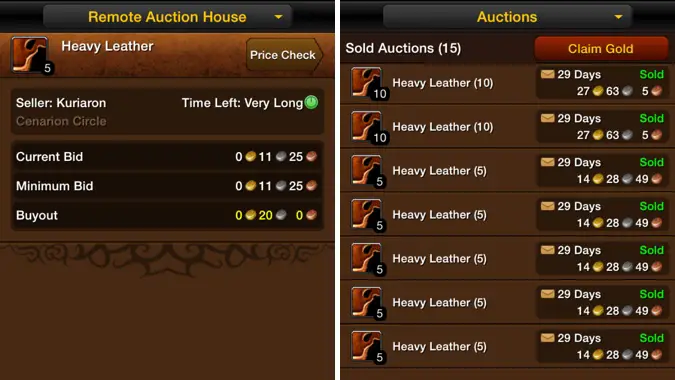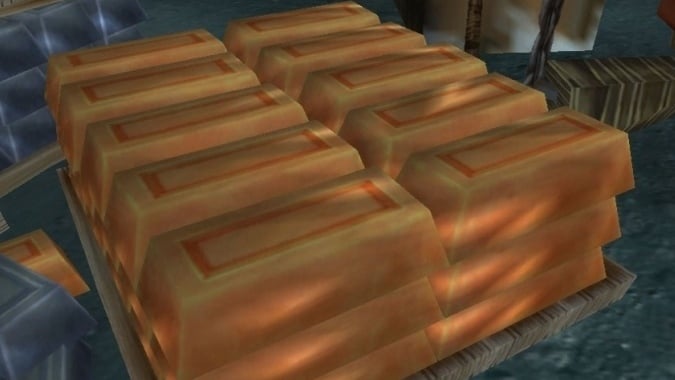How to make a million gold in World of Warcraft

Hey everyone! It’s crush-worthy millionaire industrialist Fox Van Allen, here once again to guide you to the golden promised land of World of Warcraft riches. When last we met, we talked about making WoW gold while leveling. It’s a lot of fun to do, but let’s be honest — that stuff is small potatoes. Making hundreds and thousands of gold is cool, but being a millionaire is way cooler. And that’s what you want, right? To fill a money bin with gold and go swimming in it every day until you inevitably drown in it; every bone in your elderly duck body crushed by the weight of your financial success and business dominance? Now that is the life!
Today’s column is all about getting rich — and reaching the gold cap in particular. See, it’s not hard to figure out how to make a little bit of gold in WoW. But how the heck do you scale your current gold making efforts to push beyond simply covering all your repair bills? I can’t give you all the secrets — every server is different, so the route to a million is different on each, too. But I can give you the general roadmap if you follow me after the jump.
I play an ore-collecting shadow priest on Blizzard Watch’s WoW leveling livestream (catch Fox Force Five live every Thursday afternoon on the Blizzard Watch Twitch channel). I started him with 0 gold a few months ago and have been steadily working to increase his bankroll — he’s now up to level 62 with 6,000 gold in the bank. At first, it was all about gathering ore. But now that I have some gold in my pocket, I’m expanding my business. I’m spending more gold to buy inventory to resell. The goal is to get the most amount of gold per week with the least amount of work.
Ready to roll up your sleeves and make that first million? Or maybe just earn enough to buy a couple WoW Tokens and save yourself some real-world money? Here’s how it’s done, step by money-making step.
Stage One: The gathering
If you’re building an WoW financial empire, the absolute classic way to get started is with a gathering profession. Yeah, I know, it’s a lot of work riding around the world collecting ore, herbs, leather, and the like. But it really does pay off — both in gold and business experience. And while the gold part is great, it’s the experience that’s going to help move you to stage two of your business and become a millionaire.
See, in stage one, the collecting materials bit is the easy, mindless part. What you want to pay attention to is the market you’re participating in. If you’re a miner, your goal is to learn the basics of the ore market. You want to find out a few key facts: What farmable materials are selling for the highest prices? What farmable materials are often unloaded at bargain prices? Who is your competition? What markets are saturated with competition, and what markets have few participants? The best way to learn all this is to get your hands dirty and regularly check the auction house. You can also use the Undermine Journal — it’s my preferred resource for researching current and historical auction house prices on the web.
This is also a good time to start thinking about your customers a little bit. Who is actually buying your raw materials? If you’re an herbalist, you’re likely selling to scribes (who will mill herbs for ink), alchemists (who use herbs for potions), and other herbalists. If you’re a miner, you’re selling to jewelcrafters (who prospect ore), along with engineers and blacksmiths (who need you to smelt ore into bars). Personally, I try to cater to all these customers by offering my wares in various sized stacks. Someone who is power leveling a profession will likely want to buy in stacks of 20 or 50 so they spend as little time with the AH as possible. Scribes and jewelcrafters consume mats in groups of 5, so I commonly list my ore in stacks of 5, too. And there are always people looking to buy just 1 or 2 more piece of ore or bar just to finish up whatever they’re trying to craft — and they’re likely willing to pay a slight premium per item just so they don’t have to buy a stack of 20 or 50. The more customers you cater to, the more you’re likely to sell in general. And listing items in different stack sizes only takes a few extra seconds — the extra gold is worth the time.
What’s that, you say? “But Fox — I can easily earn a starting bankroll by questing, completing garrison missions, running old raids and selling my kidneys on the black market!” And it’s true — it’s all true! (Important note: Blizzard Watch does not condone the sale of human kidneys where prohibited by law.) Here’s the catch, though: you can only scale a labor-based business so far if you’re the only employee. You’ll never get to 1,000,000 gold by doing all the work yourself. And you’ll surely never make money if you don’t actually learn everything about the markets you’re trying to earn money in.
Stage Two: Playing the market
Okay, so in theory, by now you’ve collected your share of materials and have learned all about your market. You might know, for example, that on your server cluster Copper Bars sometime sell for 2 gold a piece and sometimes sell for 20 silver each. You know that Medium Leather is often sold out on the AH, and when it is, you can get 5g for each piece. You know that you can get about 10 gold a piece out of Terocones and even more selling Nightmare Vines. And now that you know all this, it’s time to start turning that knowledge into gold.
See, in stage two, you’re not just unloading all your ore or leather to the lowest bidder — you’re getting smart about pricing. When you see a stack of Copper Bar for 20 silver each, you snap them all up and wait to list them when you can get that 2-gold-each price for them. When you see no one selling Medium Leather, you know to start unloading some of yours on the AH at double or triple the normal price. Remember that auction fees cut into your profits, so you need to push huge markups when you can get them.
Essentially, you want to focus on selling your wares at the maximum price — avoid buyers’ markets and take advantage of sellers’ markets. You also want to focus on low competition markets, because less competition means you can charge higher prices. And always keep on the lookout for arbitrage opportunities — where you can snap up something you usually sell at an unusually low price so you don’t need to gather it yourself. Because that’s what stage two is all about: shifting the bulk of the material acquisition work to other people and focusing on what really makes you money — selling high on the auction house. It’s a wealth-building stage. You need a sizable bankroll to make bulk purchases if you’re going to scale up to stage three.

I bought 5 Heavy Leather for 20 silver. I sold those same 5 Heavy Leather later the same day for 14g 28s. The more frequently you check the mobile auction house, the more frequently you can score these kinds of great deals.
Stage Three: Become a captain of industry
Okay, this is it. Stage three: It’s where you dominate the auction house, become a millionaire, buy elections, pressure Varian Wrynn to institute a flat tax that disproportionally benefits the wealthy, and generally use your cash to keep everyone else powerless and poor. It’s the American way, you guys!
In stage three, you’re too rich and important to go around farming materials for yourself. And the scale of your business requires you to look beyond the auction house for mats, too. Here, you need to find out who farms the materials you need on your server and try to work out a favorable buy-all-you-can deal outside the AH. Many farmers will gladly sell to you COD if they can get a reasonable price. Best of all, there are no auction fees when you work out deals like this. Just be ready to spend thousands — if not tens of thousands — of gold per week buying materials. And be ready to do something with it all to turn a profit.
At this point, you should have learned all the ins and outs of your markets. You not only know that Terocones are expensive, for example, but you know why — because scribes mill them to make some Burning Crusade-specific inks and glyphs. And you now have the ability to figure out what act offers you the highest profits and highest volume business — selling the Terocones, having an alt mill the Terocones for you to list pigments and inks, or making and selling the resulting glyphs.
When I was building first my one-million-gold stash, I relied heavily on the inscription profession. I had deals with a number of herb collectors, buying thousands of herbs at a time. I milled the herbs myself, and then used them to make Darkmoon Faire Cards, Decks, and Mysterious Fortune Cards in bulk. I wound up spending tens of thousands of gold per week on materials, making back several times that in profit. And at the same time, I was using some of those herbs to make a few select potions and flasks that also made me a few thousand gold a week. It’s hard to get to a million gold doing just one thing — it’s better to find a handful of incredibly profitable markets and exploit them all if you can. Focus the bulk of your time where you can make the most money, but don’t be afraid to branch out into new, potentially lucrative areas. And don’t be afraid to abandon once-lush markets if the gold dries up there.
And if competition pops up? You have a few options — you can abandon that particular market and focus on less competitive ones. Or, you can use your cash to fight back, and aggressively price your competition out of the market. Compete hard for a few days, keep the competition from making money, and they’ll move on. And if that doesn’t work, just sacrifice them to Yogg Saron, may his dark tide devour all in its wake. That’s the American way, too!
Please consider supporting our Patreon!
Join the Discussion
Blizzard Watch is a safe space for all readers. By leaving comments on this site you agree to follow our commenting and community guidelines.
 @foxvanallen
@foxvanallen




